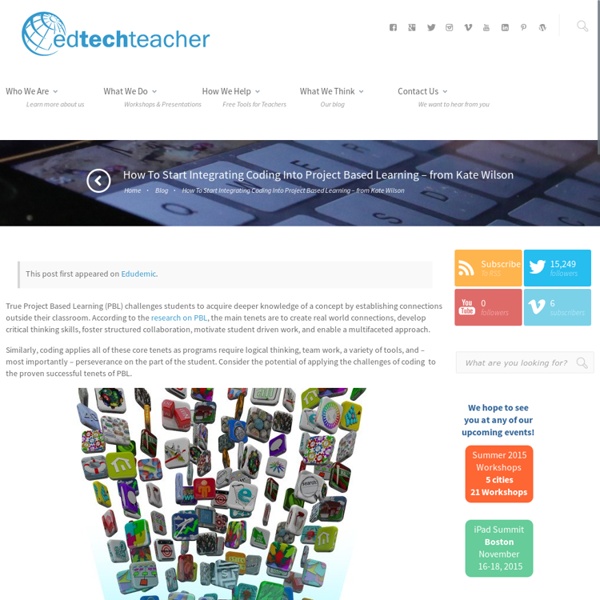How To Start Integrating Coding Into Project Based Learning - from Kate Wilson - EdTechTeacher

NOVA
Can Wind Turbines Make You Sick? Residents living in the shadows of wind turbines say the sound is making them sick. But so far the science isn't there. From NOVA Next | Jun 27, 2018 Thirty Years Ago Today, Global Warming First Made Headline News On June 23, a NASA climate scientist, James Hansen, told a U.S. From NOVA Next | Jun 23, 2018 New Middle Eastern Particle Accelerator’s Motto is “Science for Peace” In a region in turmoil, an unprecedented joint venture of scientists and policymakers is working together on Jordan’s new particle accelerator under the motto "science for peace." From NOVA Next | Jun 21, 2018 Psychological Damage Inflicted By Parent-Child Separation is Deep, Long-Lasting Here's what happens in the brain and the body when a child is forcibly separated from his or her parents.
Coding in the Classroom: 16 Top Resources
As cool as technology is, its intricacies and inner workings are sometimes intimidating, especially for young people who may be more interested in what technology can do for them rather than what they can do with technology. However, when students hurdle that obstacle and see the value of computer science — specifically coding — they gain a broadened perspective and the potential for a rewarding career in the tech field. The following resources will help you teach your students the basics of coding and will provide tips on how to keep kids interested as you go. Tools to Use in Class Can you make coding fun for your students? Absolutely! Edutopia presents a list of six resources designed to help parents get their kids interested in coding. The Facts About Coding Teaching your students to code is important, but teaching them its practical value is also key in helping them derive the most benefit from what they learn. Dr.
Free Technology for Teachers
Teach Your Kids to Code: 6 Beginner's Resources for Parents
Introducing computer programming to your kids can be a challenge, especially for those who aren’t familiar with the nuances of code. Fortunately, in the last few years, a number of apps, software, and guides have been produced that make the often-complex subject of computer coding easy to grasp for young learners. So where to begin? These are a few resources that parents can share with their kids to help them start learning about programming. Programming Tutorials From Made With Code by Google: Google's Made With Code project has a mission of encouraging girls to pursue careers in computer science. The Made With Code projects are easy to follow, and if your kids are completely new to coding, don't fret. Inspiring Articles About Kids Learning to Code Still looking for some ideas? Coding Organizations for Kids For the non-coding parents, it can be difficult to know where to begin.
Autism Software & Support | Universal Design for Learning | VizZle
ALL Reading Curriculum - ALL Literacy Curriculum
The Accessible Literacy Learning (ALL) Reading Program is an evidence-based reading instruction program that has been proven highly effective in teaching students with disabilities to read. Developed by Drs. Janice Light and David McNaughton of Penn State, ALL eliminates the need for oral responses, helping even non-verbal students learn to read. To learn more about ALL and the skills it addresses, please click here! Product Information Sheet “Finally! Pat Mirenda, Ph.D., Professor, Department of Educational and Counseling Psychology and Special Education, The University of British Columbia The ALL Reading Program is for any student with language or physical impairments who is having difficulty learning to read. Language delays Developmental delays Autism Cerebral Palsy Down syndrome Physical impairments Speech impairments Multiple disabilities Evidence-based reading instruction The ALL Reading Program was developed by Drs. “Finally! Pat Mirenda, Ph.D. June Downing, Ph.D. Research Materials
Related:
Related:



